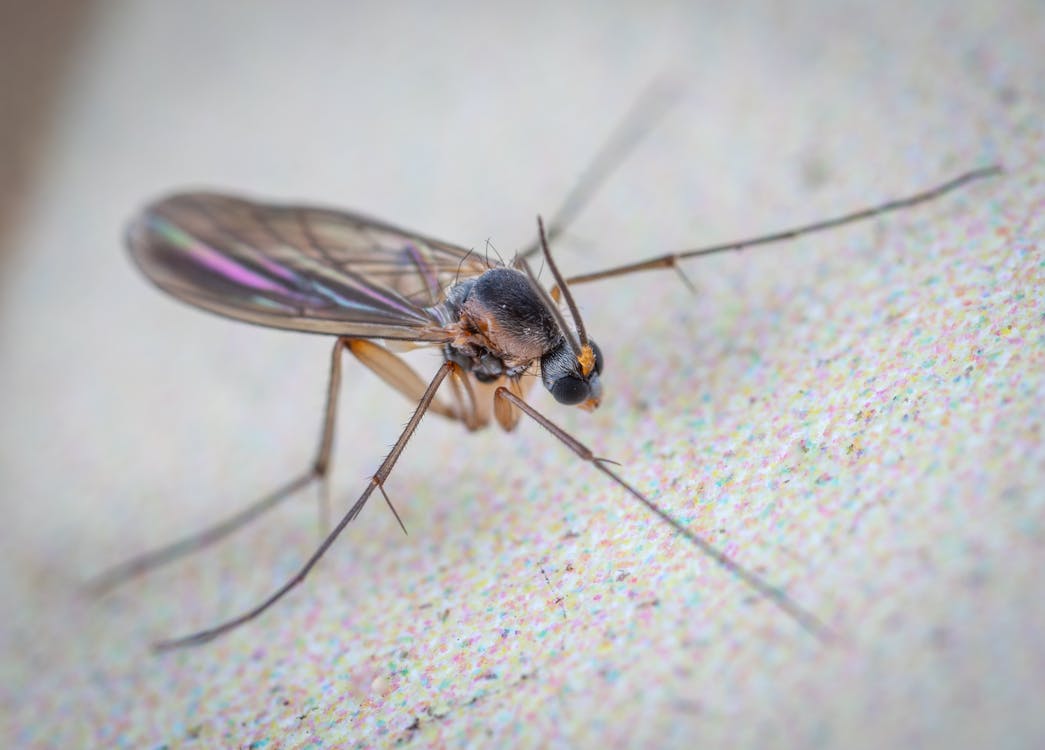Our kitchen is one of the most used rooms in our house. It is where we prepare our meals and often eat them as well. We also use it to entertain guests. Because of its high traffic, the kitchen is susceptible to pests, including gnats. Have you ever wondered why there are gnats in the kitchen?
Gnats are attracted to food and moisture, and kitchens have both abundances. Once they’re inside, they can be challenging to get rid of. But don’t worry, there are a few things you can do to get rid of gnats in the kitchen for good.
What Are Gnats?

Gnats are generally tiny insects with lengthy legs. They are usually poor flyers as well. Many little winged insects in the fly family are known as gnats. Contrary to common perception, these small flying insects are not “babies” but rather adults. There are more than 1,600 species of true gnats. The term “gnat” is derived from the Old English word “natte,” which means “midge.”
Gnats typically have dark-colored bodies and clear wings. Some species of gnats may be as small as a quarter of an inch, while others may grow up to 1/2 an inch in length.
Most species of gnats do not bite humans. However, there are a few exceptions, such as the “no see ums,” which are very small insects that can be difficult to see. These biting gnats can be quite annoying, and their bites can be painful. Some species feed on agricultural pests like aphids and scales and are good plant pollinators. Gnats like the Hessian fly, for example, are agricultural pests. Depending on the species, gnats may be biting or non-biting and feed on plants, other insects, or blood.
The life cycle of gnats
The life cycle of gnats can vary, but most species go through four stages: egg, larva, pupa, and adult.
Mating: Males of certain species form enormous mating swarms called ghosts. These swarms are especially abundant in vast areas and over streets after night.
Eggs and larvae: Gnat lays its eggs in water or land, depending on the species. Larvae may be stationary or can move through water, plants, and rocks.
Adult: Adults vary in size but are generally not more than 33 mm long. The gnat’s larval and adult phases are both useful and harmful.
Types of Gnats

There are various types of gnats, and they can be broadly classified into different species.
🦟Fruit flies
As their name suggests, fruit flies are attracted to ripened fruits and vegetables. They are also attracted to the yeasty odor of fermenting liquids. Fruit flies are small, reddish-brown, or tan insects with large red eyes. The female fruit fly can lay up to 500 eggs in her lifetime. Fruit fly larvae are tiny and worm-like.
🦟Fungus or Houseplant Gnats
There are around 1,000 different black gnats species. The fungus gnat is the most prevalent. Sometimes known as fungus gnats, winter gnats are around 1/16 to 1/8 inches long. Adults are grayish-black in color, with long see-through or gray wings with visible veins and lengthy legs. These small insects feed on fungus and plant roots.
Fungus gnat eggs are round, smooth, and shining white and are almost undetectable. They are thread-like in the larval stage, with no legs. The larvae have a blackhead and a clear, whitish-colored body. Both adults and larvae thrive in moist conditions with high humidity.
🦟Drain Gnats
Drain flies are gnats often seen near drains, sewage systems, or other damp areas. They usually breed in these places and can be found near bathroom sinks, kitchens, or basements.
Drain gnats are small, dark-colored insects with furry bodies and long wings. They are often mistaken for fruit flies. Female drain flies lay their eggs near drains, sewage systems, or other wet areas. In about two weeks, the larvae hatch from the eggs and develop into adults.
🦟Buffalo Gnats
Buffalo gnats, also known as black flies or turkey gnats, are small, blood-sucking insects. They are black or dark gray and have a humpbacked appearance. Buffalo gnats are found near streams, rivers, and other bodies of water. They breed in these areas and lay their eggs on the water surface.
Females attack animals and humans, while males feed on nectar. Buffalo gnats can transmit diseases such as river blindness and tularemia.
🦟Midges
Biting midges like marshy environments. They are also called “no see ums” because they’re so tiny – about 1/16 inch long. They have a wingspan of about 1/8 inch and are black or dark-colored with white spots on their backs. Biting midges are attracted to the carbon dioxide that humans exhale and will bite humans to get blood meals.
Non-biting midges are found near water and do not bite humans. They are attracted to light and often fly into homes through open doors and windows.
🦟Sand Flies
Sand gnats range from 1/8 to 1/10 of an inch and are named for their sandy tint. They often breed in sandy areas near coastal regions. Sand gnats are known to spread diseases like leishmaniasis, caused by a parasitic protozoan.
🦟Gall Gnats
Gall Gnats insert their larvae into plant stems, feeding on the plant tissue. This feeding causes the plant to form a gall around the larvae. Gall gnats are small, dark-colored insects with long legs and antennae. The larvae are white or yellow and have black spots on their bodies.
🦟Eye Gnats
Eye gnats or grass flies usually fixate around human and animal victims’ eyes, noses, and mouths. They tend to be found near grassy areas to breed and lay their eggs. They often spread pink eye and other diseases.
🦟Hessian Fly
The Hessian fly is a small, black, or dark-colored insect often found near wheat fields. It usually breeds in these places and can be found on the stems of wheat plants.
🦟Gnat bugs
Unique-headed bugs or gnat bugs come in 130 different species. The term comes from their enormous skull, restricted in certain spots. They’re often mistaken for aphids because they have a beak-like mouthpart called a stylet. Gnat bugs pierce their victims and suck out the plant juices.
What Is A Gnat Infestation?
Fruit flies may enter houses via screens and open doors and eggs and larvae on fruits and vegetables. They devour and develop in overripe fruits and vegetables once inside. Fruit flies are also likely to grow in the following places:
- Unclean drains
- Garbage cans
- Moist areas with organic debris that is decaying
Because fruit flies may lay up to 500 eggs, infestations are frequent and can last for months. Gnat infestation results from these small, black insects breeding and living in unsanitary conditions. If you have a gnat infestation, you may see small, black bugs flying around your home or notice them on your food. Gnats are not only a nuisance, but they can also carry diseases.
Why Are There Gnats In The Kitchen?

Organic material and moisture attract gnats, so you’ll see more of them in the summer than in the winter. They usually come inside the home looking for food and a spot to reproduce. They like rotting organic material, such as rotting fruit or decaying leaves. Grants also like damp spots within the house, like clogged sinks and drains or wet potting soil.
Here are some other things that can attract gnats:
👉Overripe fruits or vegetables
Gnats are attracted to the sugars in overripe fruits and vegetables. Once they land on the fruit, they lay their eggs. The larvae then hatch and feed on the fruit.
👉Light
Gnats are attracted to light, so you may see them flying around your windows or near lamps.
👉Unclean garbage cans
Gnats are attracted to the garbage in your trash can. If you don’t clean your garbage can regularly, it can attract gnats and other pests.
👉Dirty dishes
If you have dirty dishes in your sink, it can attract gnats. They’re attracted to the food and moisture on the dishes.
👉Decaying leaves or organic matter
Fungus gnats are attracted to decaying plants and flowers. Compost, moss, mold, and fungus are among the foods they eat. They often dwell in your potting soil, where they may feed on decomposing leaves or root rot.
👉Humans
Gnats are attracted to the carbon dioxide that humans exhale. They may fly around your head or land on your skin, searching for a meal.
👉Clogged drains or moist areas
Kitchen puddles, food spills, overwatered plants or grass, leaking pipes beneath the sink, wet potting soil, condensation near vents and windows are all moist breeding places for gnats.
👉Wet potting soil
If you have plants in your home, the potting soil may be a breeding ground for gnats. They’re attracted to the moisture in the soil.
How To Quickly Get Rid of Gnats in The Kitchen

One simple home error, such as leaving out ripe fruit, can cause a gnat infestation. To get rid of these pests, you need to find and eliminate their breeding ground. Once you’ve done that, you can take steps to keep them from coming back.
🛑Locate their breeding ground.
The first step is to find where the gnats are coming from. Look for any moist areas in your kitchen. Once you’ve found the source of the moisture, you can begin to get rid of the gnats. If you can’t find the source, or if there are multiple sources, you can try using a gnat trap.
🛑Use rotting fruit to entice them into a trap.
One way to get rid of gnats is to use their breeding ground against them. Place some overripe fruit, such as bananas, in a jar. Cover the top of the jar with plastic wrap and poke holes in it. The gnats will be attracted to the fruit and fly into the jar. Once they’re in, they won’t be able to get out.
🛑Use flypaper or a sticky trap.
You can also use flypaper or a sticky trap to get rid of gnats. These traps work by attracting the gnats with a sweet scent and then trapping them on the sticky surface.
🛑Use apple cider vinegar to make a trap.
Combine a half cup of warm water, one tablespoon of sugar, two tablespoons apple cider vinegar, and roughly six drops of dish soap in a small mixing basin. Stir gently to mix the ingredients, and then pour the mixture into a jar or cup. Cover the top of the container with plastic wrap and poke small holes in it. The gnats will be attracted to the sweet scent and fly into the trap.
🛑Try a bug zapper.
You can also try using a bug zapper to get rid of gnats. These devices attract pests with a light and then electrocute them.
🛑Try using a chemical spray.
When things get worse, and you can’t seem to get rid of the gnats, you may need to use a chemical spray no matter what you try. You can also eliminate other pests like cockroaches with it. Be cautious when handling these chemicals and always follow the manufacturer’s instructions.
🛑Make a candle trap.
You can also try using a candle trap to get rid of gnats. Light a candle and place it in a bowl. Turn off the lights in the room and wait for the gnats to get near the flame. The heat from the candle will attract the gnats, and they will fly into the bowl and be incinerated. You can then blow out the candle and dispose of the gnats.
🛑Use a diluted bleach solution.
If you’ve seen gnats gathering around your sink drains, they may be coming up from the pipes. Pour a half cup of bleach down each drain and plug the drains with a rag. Let the bleach sit for an hour, and then flush the drains with hot water.
Prevent Gnats In The First Place

Now that you know how to get rid of gnats, you need to take steps to prevent them from coming back. The best way to do this is to remove their breeding ground.
✔Clean your kitchen regularly.
The first step in preventing gnats is to keep your kitchen clean. Wipe up spills and crumbs immediately. Don’t let dirty dishes pile up in the sink. And be sure to take out the trash regularly.
✔Keep your fruit fresh.
Another way to prevent gnats is to keep your fruit fresh. Gnats are attracted to overripe or rotting fruit. So, be sure to eat your fruit before it goes bad. Store it in the fridge if you’re not going to eat it right away. And don’t let it sit out on the counter for too long.
✔Replace your trashcans regularly.
Gnats, like other insects, will flock to an overflowing rubbish can. So, it’s important to empty your trashcans regularly. And be sure to clean them out with soapy water every once in a while. Covering your trashcans with a lid will also help keep the gnats away.
If you have a lot of fruit and vegetable scraps, you can compost them instead of putting them in the trash. Just be sure to keep your compost bin clean and covered so that the gnats don’t have a chance to get in.
✔Be sure to seal up food.
Another way to prevent gnats is to make sure all your food is properly sealed up. Gnats love the smell of food. That’s why they will be attracted to any open packages. Be sure to store all food in airtight containers.
✔Eliminate damp spots.
Gnats also like damp areas. So, it’s important to eliminate any damp spots in your kitchen. Wipe up any spills immediately, and be sure to fix any leaks. You should also avoid leaving wet towels or rags lying around. And be sure to clean out your sink drains regularly to prevent them from getting clogged and holding water.
✔Avoid overwatering your plants.
If you’re attempting to avoid a gnat infestation, you should also avoid overwatering your plants. Gnats love to swarm on damp soil, so only water your plants when the soil is dry. And be sure to empty any water collected in plant saucers. You can also add a layer of sand to the top of the soil to help prevent gnats from laying their eggs.
✔Stop pouring oils down the drain.
It may not only harm your pipes and create plumbing issues, but it can also invite gnats into your house. If you pour oil down the drain, it can create a film that will attract gnats. So, be sure to dispose of cooking oils in the trash instead.
✔Use a stopper for your drain.
Drains are where phorid flies and fungus gnats and phorid flies commonly enter your kitchen. So, it’s important to keep them covered. You can purchase a drain stopper at your local hardware store. Or you can make your own by cutting a circular piece of sponge and placing it over the drain.
As you can see, there are several things you can do to get rid of gnats and prevent them from coming back. You can keep your kitchen free of these pesky pests by taking simple preventive measures.
Frequently Asked Questions
Q: What is the average lifespan of gnats?
A: Most gnats only live for around two weeks. However, the eggs can survive for up to two months without hatching.
Q: What do gnats eat?
A: Gnats are attracted to overripe or rotting fruit. They will also feed on plant sap, fungi, and decaying matter.
Q: What is the best way to eliminate gnats in my kitchen sink?
A: You can use a drain stopper to prevent gnats from entering your kitchen sink. Or you can pour a cup of boiling water down the drain once a week to kill any eggs that may be present.
Q: Is it possible to kill gnats with a vinegar trap?
A: Yes, killing gnats with a vinegar trap is possible. All you need is a bowl, some apple cider vinegar, and a piece of paper. Simply mix equal parts of apple cider vinegar and water in the bowl to make the trap. Then, place the piece of paper over the top of the bowl and secure it with a rubber band. The gnats will be attracted to the vinegar and fly into the bowl. Once they’re in, they won’t be able to get out, and they’ll eventually drown.
Q: What essential oils will keep gnats away?
A: Many essential oils can help to keep gnats away. Some of the most effective oils include citronella, lavender, eucalyptus, and lemongrass. You can either diffuser these oils in your kitchen or add them to a spray bottle full of water and use them to mist your kitchen.
Final Thoughts
Gnats can be a real nuisance in your kitchen. We cook and eat in our kitchens, so we don’t want them anywhere near our food. Luckily, there are several things you can do to get rid of gnats and prevent them from coming back.
But by taking some simple precautionary measures, you can prevent them from taking over. Be sure to store all food in airtight containers, eliminate damp spots, and avoid overwatering your plants. It would help if you also use a drain stopper or pour boiling water down your drains regularly. And if you’re looking for a natural way to keep gnats away, try using essential oils.
Keep your kitchen clean and free of gnats by following these tips.
